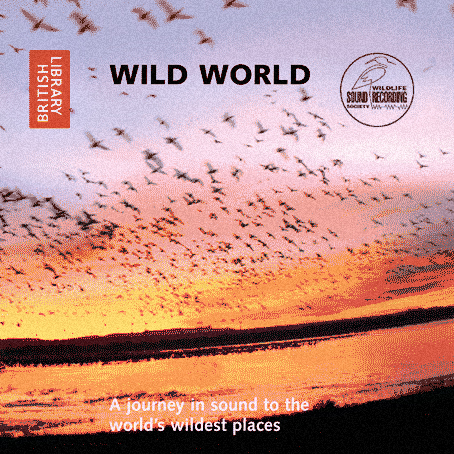Wild world. WILDLIFE RECORDING SOCIETY
(British Library 2011)
Wild World is a two-cd release which presents field recordings of untouched spaces from around the globe. The recordings date from 1988 to 2007 and were contributed by various members of the Wildlife Sound Recording Society. The first c.d transports us to the woodlands and lakes of the European continent, while the second c.d features sounds captured in the forests of Australasia and South America. The focus of the field recordings is predominantly centred upon birdlife, however other animals including squirrels, indri, frogs and a hippopotamus also feature in the release.
Wild World‘s most immediate appeal is through its presentation of the contrasting biophonies that exist between the different continents. The exotic piercing calls of forest birds raise us to the canopy of tropical rainforests across South America and Asia, while the more subdued chatter of woodland birds reflect the temperate woods of western Europe. By presenting these regions separately on two cd’s it is possible to hear a distinction between them. The vocalisations of the European woodland birds are often short, high-pitched and fast. Their calls overlap each other indicating a high level of group socialisation, whereas the calls of the tropical forest birds are often solitary, louder, and longer in duration. This is perhaps a sonic adaptation to communicating through the dense foliage in which they live; a place where the auditory faculties are often more important than the visual. Aquatic birds also feature on Wild World, the most haunting of which belonging to the Common Loon. Its long call echoes throughout a Canadian river valley, creating a mournful atmosphere. That these affective qualities are caught by the recordist and then transferred to an audience highlights the potency of field recording.
The sounds of non-bird species provide a balance to Wild World. One track features a chorus of tree frogs from Puerto Rico in the foreground while in the background a dog barks, adding a strong spatial dimension to the recording. A personal favourite is of the indri, one of the world’s largest lemurs, whose collective call dominates the Madagascan forests. For over seven minutes a family of indri communicate from the tree-tops, their melancholic calls resembling those of whales.
Moving beyond the enjoyment of Wild World‘s exotic sounds lies an urgent message concerning the ongoing survival of these spaces. As many of the recordings were taken in developing countries we are moved to question the future of these untouched habitats. Which of these sounds will survive a region’s transition into industrialisation? What has already been lost since the recordings were made? What will the future soundscape contain, what will be missing? These questions are an important part of Wild World‘s listening experience and once posed they cannot be ignored. As one of the Wildlife Sound Recording Society’s aims is to offer support for scientific study the recordings presented in Wild World will be a valuable resource when comparing the health of these habitats in the future. The emotional resonance stirred by Wild World‘s recordings might also provoke some listeners to engage with their environment in a more sympathetic way. One of the first steps in this process is potentially through the act of listening. It is here that the power and significance of Wild World, and field recording itself, reside.
-Jay-Dea Lopez
Wildlife Sound Recording Society website
British Library website


